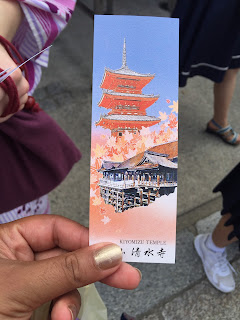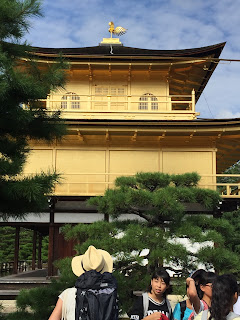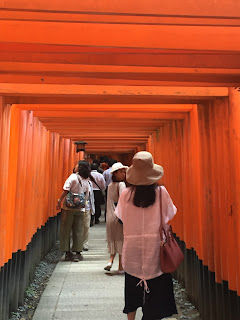A short post today. I had the chance to go to a garden that is 150 years old. It is attached to an old Japanese house that is now a museum. Japanese gardens are an art form in themselves. They are planed to mimic nature, but also create a calming and meditative environment. Everything from the plants, to the water, to the rocks used, to the spirit houses, help to create this wonderful setting. I hope you enjoy the sound of the rain in the garden.
Monday, September 19, 2016
Saturday, September 10, 2016
Kyoto Temples: Kiyomizu Temple, The Golden Pavillion, and the Red Gates.
I spent two days in Kyoto, Japan! Kyoto is seen as the art and cultural center of Japan! It is beautiful and there is so much to see! This is a long post full of pictures! I didn't have much time to make long videos because most of the places were crowded and we ran from place to place. But i do have a sort video at the end that combines the few videos I was able to make! I hope you guys enjoy them!
Men also wear yukata! But the men's designs are less colorful, more simple, and have less accoutrements.
We saw this famous state of Izumo no Okuni, a famous Kabuki Dancer. Kabuki is a form of Japanese performance. It usually involves acting, like in plays, dancing, and elaborate costumes. This dancer would dress like a man and perform for audiences in 1603. She was the most beloved dancer and made Kabuki popular. But during the Edo Period female kabuki artists were banned and all the parts became played by men. This is still how it is today! This statue was put up for the 400 year anniversary of the creation of Kabuki!
The shrine below is very colorful because of the balls of fabric attached to them. For a small donation, visitors write their wishes onto the balls and hang them on the shrine on the hope that they will get their wish!
We also had the chance to see a Maiko Performance. But I was not allowed to take pictures. A Maiko is a sort of Geisha in training. They spend many years learning the arts, dancing, how to serve, music, story telling. They are very accomplished, and it is an honor to be served and entertained by a Geisha. They also have special makeup, kimono, shoes, and hair accessories. The look is applied according to strict rules and traditions, which are dictated by rank, age, and stage of training.
The first temple we stopped at was Kiyomizu Temple, a famous Buddhist temple that is also a UNESCO world heritage site! This means that it is of great cultural and global significance. The temple was founded in 778 and most of the present buildings were built in 1633. Here is the opening gate to the temple! All of the buildings and gates are made of wood. They are painted in colorful designs with enamel paints, gold leaf, and metal accessories.
The temples are made of several buildings, shrines, tea houses, gates, gardens and towers.
This section of the main building is called the leap of faith. It is a slanted ledge built on the side of the building. At one time there were no guard rails at the end, so it was very possible to fall off! But today visitors can go to right to the edge to prove their courage and faith, or just take cool pictures.
This is the entrance gate to the famous LOVE STONE! Read the famous story below!
There is also a worry pool. You write your worries on the paper and place it in the water. When it dissolves your worries are carried melted.
The Gardens! There are many gardens and trails surrounding the temples. Many have Buddhist sculptures and spirit houses. Many also are set up using the directions and teachings of zen Buddhism. There are even small streams, fountains, and pools where visitors can symbolically cleanse themselves of their worries.

That was our first temple! It was beautiful and so fun to walk through, but now we had to move on to our next visit! We were hungry, so we got some green tea "Matcha" ice cream. It was very good, but unlike American ice cream it was bitter! we had to balance the taste out with some red bean paste (the brown ball) and some Mochi (a sweet made of rice)!
We also stopped to watch a street artist draw a portrait of a woman and listened to street musician playing the guitar. The streets of Kyoto are filled with artists creating beautiful art!
As it got later we saw many people just sitting and hanging out together outside. It was wonderful!
It was a busy day so we decided to keep the rest of the temples for the next day! Here is the path leading up to the Rokuon-ji Temple, where the Golden Pavilion stands. Like the other temples, this one is surrounded by beautiful moss covered gardens, trails, paths, lakes, ponds, streams, and tall old trees.
As we walked down the path, more and more people joined us. We eventually turned down a bend and found The Golden Pavilion.
The Golden Pavilion (Kinkaku) is part of the Buddhist Rokuon-ji Temple. It is said that relics of Buddha are found in the Pavilion. The gardens and buildings on the temple grounds are "said to represent the Pure Land of Buddha in this world" (Golden Pavilion Pamphlet). The original temple was built by the third shogun of the Muromachi period, Yoshimitsu Ashikaga, in 1397. The Temple was made a World Heritage Site in 1994.
The Pavilion is composed of 3 stories in 3 different styles. Floor number one is in a Japaneses Nobel-men's style, the second is a samurai warrior style, and the top level is a zen temple style. The two top floors are guided in gold leaf and sealed in lacquer. The building was burned down in 1950, but rebuilt in 1955. The gold was put back on in 1987.

This is the outdoor area of the famous Sekkatei tea house. The tea ceremony has been special to Japan for 100s of years. Tea ceremonies are performed at special times. It is seen as a great honor to have a ceremony performed for you. Visitors to this tea house today can relax with tea and sweets...
The tea is a bitter green tea called Matcha. It is traditional to dink the tea in 3 sips and it is OK to slurp! The tea is also served with some sweets to counteract the bitter tea.
At the end of the temple was a small area where visitors could buy snacks. Here we found an ice cream vending machine!It included some Hershey ice cream!
We finally made it to our last temple, the Fushimi Inari Taisha, or shrine of Inari on Mt. Inari. Inari, is the god of rice in Japan. There are the opening gates or Torii. These first gates led to a small street full of shops and food vendors.
The first buildings of the temple were built in 711 with the main building being built in 1499.
The shrine is best known for its trail of red gates or torii that go up a mountain path. It is about 4 kilometers long and takes about 2 hours to walk. Each gate was funded by a Japanese business. They are replaced as they become too old to stand. Each gate has the business name and the date it was constructed. Inari is traditionally worshiped by businesses and manufacturers.
These stone monuments are called Otsuka. They have the names of many kami (Shinto Spirits) carved into them.
"Katsune" the Japanese name for foxes are usually servants of Inari. Many Katsune sculptures cover the mountain paths. Katsune are tricksters and in Japanese folklore the can shape shift into humans and cause mischief!
This section of the gates is called the 1000 gates. 1000 wooden gates climb up the mountain path
After climbing up the mountain we were hungry so we got some Ramen! Ramen in Japan is not like ramen in the USA. The broth is simmered for hours and the toppings are all cooked specially for each customer. It was delicious!
This is the city or artisans, geisha, and numerous Temples and Shrines! We saw 3 major Temples: Kiyomizu Temple, The Golden Pavillion, and The Red Gates!
First we had to get dressed in style! My friends, Lindsay and Mami, and I rented Yukata, a summer form of Kimono or Japanese Robe. The outfit is very intricate and involves several pieces: An under-robe, a waist belt, a colorful Yukata, made of light cotton so it will breathe in the summer heat, and an Obi, or wide belt that is tied into an intricate bow! Brighter colors are usually for young women while darker colors are for older women. We also got our hair done and got to choose shoes and a bag! The shoes were made of wood, but very comfortable, like flip flops!
 |
| Obi Bow |
 |
| The Obi |
 |
| Men's Yukata |
We walked along some old and famous streets filled with shops and restaurants.
 |
| A bronze Street Marker |
We also saw some unexpected things like a coffee grinder made in Philadelphia, Pennsylvania!
And this very funny statue!
We also passed many shrines, gardens, and small temples. They can be seen all over Kyoto. Most are tied to Shinto and Buddhist traditions, two religions found in Japan.The architecture is influenced by Chinese architecture, but the Japanese have made this style their own.
The shrine below is very colorful because of the balls of fabric attached to them. For a small donation, visitors write their wishes onto the balls and hang them on the shrine on the hope that they will get their wish!
We also had the chance to see a Maiko Performance. But I was not allowed to take pictures. A Maiko is a sort of Geisha in training. They spend many years learning the arts, dancing, how to serve, music, story telling. They are very accomplished, and it is an honor to be served and entertained by a Geisha. They also have special makeup, kimono, shoes, and hair accessories. The look is applied according to strict rules and traditions, which are dictated by rank, age, and stage of training.
 |
| Kanzashi Geisha Hair Accessories |
 |
| Poster for a Maiko Performance |
The first temple we stopped at was Kiyomizu Temple, a famous Buddhist temple that is also a UNESCO world heritage site! This means that it is of great cultural and global significance. The temple was founded in 778 and most of the present buildings were built in 1633. Here is the opening gate to the temple! All of the buildings and gates are made of wood. They are painted in colorful designs with enamel paints, gold leaf, and metal accessories.
The temples are made of several buildings, shrines, tea houses, gates, gardens and towers.
This is my ticket! Isn't it beautiful?
There are also several sculptures including this sculpture representing the story of dragons.
Here are the views from the main tower of the temple.
This section of the main building is called the leap of faith. It is a slanted ledge built on the side of the building. At one time there were no guard rails at the end, so it was very possible to fall off! But today visitors can go to right to the edge to prove their courage and faith, or just take cool pictures.
There is also a worry pool. You write your worries on the paper and place it in the water. When it dissolves your worries are carried melted.
The main tower of the temple!
The Gardens! There are many gardens and trails surrounding the temples. Many have Buddhist sculptures and spirit houses. Many also are set up using the directions and teachings of zen Buddhism. There are even small streams, fountains, and pools where visitors can symbolically cleanse themselves of their worries.

Along the way we passed another famous temple! They are everywhere.
We also stopped to watch a street artist draw a portrait of a woman and listened to street musician playing the guitar. The streets of Kyoto are filled with artists creating beautiful art!
As it got later we saw many people just sitting and hanging out together outside. It was wonderful!
We also had the chance to go to a Ninja Restaurant! And we got to eat Ninja Stars!
It was a busy day so we decided to keep the rest of the temples for the next day! Here is the path leading up to the Rokuon-ji Temple, where the Golden Pavilion stands. Like the other temples, this one is surrounded by beautiful moss covered gardens, trails, paths, lakes, ponds, streams, and tall old trees.
Here is a map of the entire temple! The grounds are very vasts so this map was a big help to us.
I thought this time dog protector on the roof was funny but also beautifully carved. I also loved the carvings on the ends of the roof symbols. You can find many small sculptures and carvings like this in both Chinese and Japanese architecture.
As we walked down the path, more and more people joined us. We eventually turned down a bend and found The Golden Pavilion.
The Golden Pavilion (Kinkaku) is part of the Buddhist Rokuon-ji Temple. It is said that relics of Buddha are found in the Pavilion. The gardens and buildings on the temple grounds are "said to represent the Pure Land of Buddha in this world" (Golden Pavilion Pamphlet). The original temple was built by the third shogun of the Muromachi period, Yoshimitsu Ashikaga, in 1397. The Temple was made a World Heritage Site in 1994.
The Pavilion is composed of 3 stories in 3 different styles. Floor number one is in a Japaneses Nobel-men's style, the second is a samurai warrior style, and the top level is a zen temple style. The two top floors are guided in gold leaf and sealed in lacquer. The building was burned down in 1950, but rebuilt in 1955. The gold was put back on in 1987.
The gardens surrounding the Pavilion. It was a beautiful place.
Here is the ticket for my entrance. The tickets here are works of art in themselves.
The back and top of the pavilion.

On the top of the building is a Ho-o, a Chinese bird.
This is the outdoor area of the famous Sekkatei tea house. The tea ceremony has been special to Japan for 100s of years. Tea ceremonies are performed at special times. It is seen as a great honor to have a ceremony performed for you. Visitors to this tea house today can relax with tea and sweets...
...which we did!
The tea is a bitter green tea called Matcha. It is traditional to dink the tea in 3 sips and it is OK to slurp! The tea is also served with some sweets to counteract the bitter tea.
At the end of the temple was a small area where visitors could buy snacks. Here we found an ice cream vending machine!It included some Hershey ice cream!
We next caught a bus to our next temple. We saw the Kyoto tower on the way! It is one of Kyoto's famous landmarks.
The first buildings of the temple were built in 711 with the main building being built in 1499.
The shrine is best known for its trail of red gates or torii that go up a mountain path. It is about 4 kilometers long and takes about 2 hours to walk. Each gate was funded by a Japanese business. They are replaced as they become too old to stand. Each gate has the business name and the date it was constructed. Inari is traditionally worshiped by businesses and manufacturers.
 |
| An ornate wooden lantern |
These stone monuments are called Otsuka. They have the names of many kami (Shinto Spirits) carved into them.
"Katsune" the Japanese name for foxes are usually servants of Inari. Many Katsune sculptures cover the mountain paths. Katsune are tricksters and in Japanese folklore the can shape shift into humans and cause mischief!
This section of the gates is called the 1000 gates. 1000 wooden gates climb up the mountain path
A cleansing center where visitors can cleanse their minds and bodies.
A map of the mountain!
These are offerings at one of the many shrines on the mountains. Many are wishes from visitors. Hopefully Inari grants them good fortune!
Here is a video if the gardens and gates. I hope you enjoy it!
After climbing up the mountain we were hungry so we got some Ramen! Ramen in Japan is not like ramen in the USA. The broth is simmered for hours and the toppings are all cooked specially for each customer. It was delicious!
 |
| YUUUUM!!! |
Subscribe to:
Posts (Atom)








































































































































































